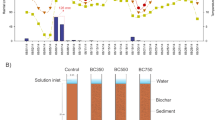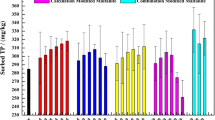Abstract
Background and aim
Many rivers have to receive treated or untreated wastewater as the main water sources in the world, especially in the countries facing with water shortage. For instance, the Haihe and Huaihe River Basin, which are among areas facing crises for water resources in China, receive 33,400 million tons of wastewater per year. As the sediment has large capacity for sorbing hydrophobic organic pollutants such as polycyclic aromatic hydrocarbons (PAHs), it can act as a natural repository for the contaminants. This means pollutants can release into water phase again under some conditions, such as resuspension, sediment dredging, etc. The objective of this research was to study the trends of PAH release from sediments in rivers receiving much wastewater, such as Yongding New River (YD), Northsewer (NS), and Southsewer (SS) from Haihe River Basin. These rivers received most of the wastewater from Tianjin, China and merge into Bohai Bay finally.
Methods
Sediments (namely YD, NS, and SS) were collected from Yongding New River, Northsewer, and Southsewer, respectively. The physical and chemical properties of the sediments, including particle size distribution, total organic carbon (TOC) and black carbon (BC) contents, elemental compositions, organic functional groups analyzed from Fourier transformed infrared (FTIR), and nuclear magnetic resonance (NMR) spectra, were characterized. PAH desorption from the sediments was measured with the Tenax shaken slurry desorption method.
Results
The NS sediment had a greatly higher TOC and BC contents, while lower BC-to-TOC ratio than YD and SS sediments. NMR and FTIR analysis showed that aliphatic carbons were more abundant in NS sediment than SS sediment. The desorption experiments showed that PAHs desorbed more rapidly from YD and NS sediments than from SS sediment. PAH fraction desorbed after each interval during the experiment except 0.8 day was significantly correlated with PAH properties among all the three sediments.
Discussion
The higher BC-to-TOC ratio in SS sediment corresponded to slower desorption rate and less desorption extent of PAHs from SS sediment among the three sediments. This probably could be explained by the extremely strong sorption ability of BC. It also proved that the sequestration of PAHs in sediment was not simply the result of higher organic carbon content.
Conclusions
Considering the physical and chemical characterization of the sediments and PAH desorption properties comprehensively, BC-to-TOC ratio was a more important factor controlling the behavior of PAHs in sediments than absolute TOC or BC content.




Similar content being viewed by others
References
Abu A, Smith S (2005) Assessing sequestration of selected polycyclic aromatic hydrocarbons by use of adsorption modeling and temperature-programmed desorption. Environ Sci Technol 39:7585–7591
Accardi-Dey A, Gschwend MP (2002) Assessing the combined roles of natural organic matter and black carbon as sorbents in sediments. Environ Sci Technol 36:21–29
Accardi-Dey A, Gschwend MP (2003) Reinterpreting literature sorption data considering both absorption into organic carbon and adsorption onto black carbon. Environ Sci Technol 37:99–106
Allen-King MR, Grathwohl P, Ball PW (2002) New modeling paradigms for the sorption of hydrophobic organic chemicals to heterogeneous carbonaceous matter in soils, sediments, and rocks. Adv Water Resour 25:985–1016
Belzile N, Joly HA, Li HB (1997) Characterization of humic substances extracted from Canadian lake sediments. Can J Chem 75:14–27
Bucheli DT, Gustafsson Ö (2000) Quantification of the soot-water distribution coefficient of PAHs provides mechanisms basis for enhanced sorption observations. Environ Sci Technol 34:5144–5151
Cornelissen G, Gustafsson Ö (2004) Sorption of phenanthrene to environmental black carbon in sediment with and without organic matter and native sorbates. Environ Sci Technol 38:148–155
Cornelissen G, Van Noort CMP, Govers AJH (1997) Desorption kinetics of chlorobenzenes, polycyclic aromatic hydrocarbons, and polychlorinated biphenyls: sediment extraction with Tenax and effects of contact time and solute hydrophobicity. Environ Toxicol Chem 16:1351–1357
Cornelissen G, Rigterink H, Ferdinandy MAM, Van Noort CMP (1998) Rapidly desorbing fractions of PAHs in contaminated sediments as a predictor of the extent of bioremediation. Environ Sci Technol 32:966–970
Cornelissen G, Gustafsson Ö, Bucheli DT, Jonker TOM, Koelmans AA, Van Noort CMP (2005) Extensive sorption of organic compounds to black carbon, coal, and kerogen in sediments and soils: mechanisms and consequences for distribution, bioaccumulation, and biodegradation. Environ Sci Technol 39:6881–6895
Ghosh U, Talley WJ, Luthy GR (2001) Particle-scale investigation of PAH desorption kinetics and thermodynamics from sediment. Environ Sci Technol 35:3468–3475
Gustafsson Ö, Haghseta F, Chan C, Macfarlane J, Gschwend MP (1997) Quantification of the dilute sedimentary soot phase: implications for PAH speciation and bioavailability. Environ Sci Technol 31:203–209
Ibarra JV, Juan R (1985) Structural changes in humic acids during the coalification process. Fuel 64:650–656
Luthy GR, Aiken RG, Brusseau LM, Cunningham DS, Gschwend MP, Pignatello JJ, Reinhard M, Traina JS, Weber JW, Westall CJ (1997) Sequestration of hydrophobic organic contaminants by geosorbents. Environ Sci Technol 31:3341–3347
Mai BX, Fu JM, Sheng GY, Kang YH, Lin Z, Zhang G, Min YS, Zeng EY (2002) Chlorinated and polycyclic aromatic hydrocarbons in riverine and estuarine sediments from Pearl River Delta, China. Environ Pollut 117:457–474
Mai BX, Qi SH, Zeng EY, Yang QS, Zhang G, Fu JM, Sheng GY, Peng PA, Wang ZS (2003) Distribution of polycyclic aromatic hydrocarbons in the coastal region off Macao, China: assessment of input sources and transport pathways using compositional analysis. Environ Sci Technol 37:855–4863
Nam K, Chung N, Alexander M (1998) Relationship between organic matter content of soil and the sequestration of phenanthrene. Environ Sci Technol 32:3785–3788
Oen MPA, Cornelissen G, Breedveld DG (2006) Relation between PAH and black carbon contents in size fractions of Norwegian harbor sediments. Environ Pollut 141:370–380
Qiao M, Wang CX, Huang SB, Wang DH, Wang ZJ (2006) Composition, sources, and potential toxicological significance of PAHs in the surface sediments of the Meiliang Bay, Taihu Lake, China. Environ Int 32:28–33
Rockne JK, Shor ML, Young YL, Taghon LG, Kosson SD (2002) Distributed sequestration and release of PAHs in weathered sediment: the role of sediment structure and organic carbon properties. Environ Sci Technol 36:2636–2644
Shi Z, Tao S, Pan B, Liu WX, Shen WR (2007) Partitioning and source diagnostics of polycyclic aromatic hydrocarbons in rivers in Tianjin, China. Environ Pollut 146:492–500
Shor ML, Rockne JK, Taghon LG, Yong YL, Kosson SD (2003) Desorption kinetics for field-aged polycyclic aromatic hydrocarbons from sediments. Environ Sci Technol 37:1535–1544
Song JH, Peng PA, Huang WL (2002) Black carbon and kerogen in soils and sediments. 1. Quantification and characterization. Environ Sci Technol 36:3960–3967
Tianjin Environmental Protection Bureau (2006) Environmental quality report of Tianjin in 2001–2005. Tianjin Environmental Protection Bureau, Tianjin, pp 79–80
Yang C, Huang WL, Xiao BH, Yu ZQ, Peng PA, Fu JM, Sheng GY (2004) Intercorrelations among degree of geochemical alterations, physicochemical properties, and organic sorption equilibria of kerogen. Environ Sci Technol 38:4396–4408
Acknowledgments
This work was supported by the National Basic Research Program of China (Grant 2007CB407301), Sino-Swiss Science and Technology Cooperation for Joint Research Projects (GJHZ0908), and Natural Science Foundation for the Youth (40701165).
Author information
Authors and Affiliations
Corresponding author
Additional information
Responsible editor: Henner Hollert
Rights and permissions
About this article
Cite this article
Qi, W., Liu, H., Qu, J. et al. PAH desorption from sediments with different contents of organic carbon from wastewater receiving rivers. Environ Sci Pollut Res 18, 346–354 (2011). https://doi.org/10.1007/s11356-010-0379-y
Received:
Accepted:
Published:
Issue Date:
DOI: https://doi.org/10.1007/s11356-010-0379-y




